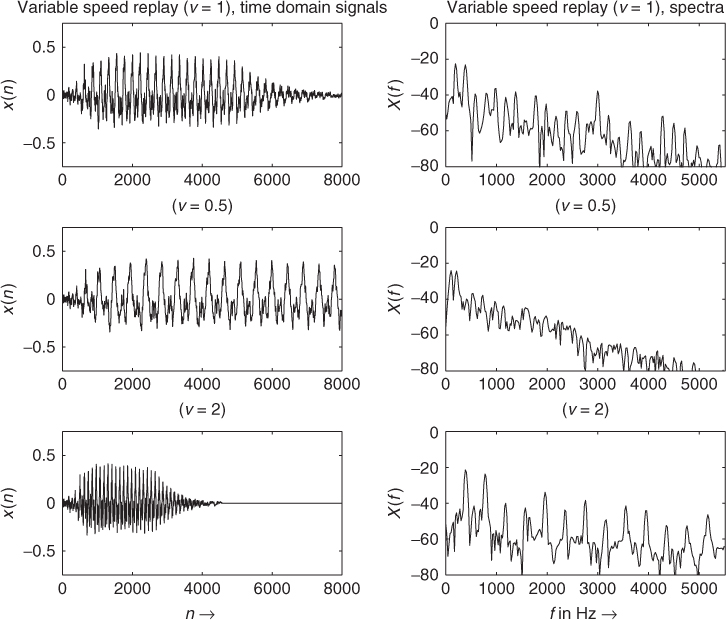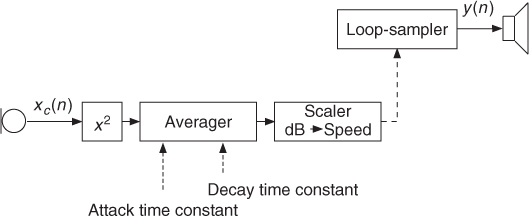Introduction
Analog audio tape recorders allow replay with a wide range of tape speeds. Particularly in fast forward/backward transfer mode, a monitoring of the audio signal is possible which can be used to locate a sound. During faster playback the pitch of the sound is raised and during slower playback the pitch is lowered. With this technique the duration of the sound is lengthened if the tape is slowed down, and shortened if the tape speed is increased. Figure 6.1 illustrates a sound segment which is lengthened and shortened, and the corresponding spectra.
Figure 6.1 Pitch shifting: Variable speed replay leads to time compression/expansion and compression and expansion of the spectral envelope.

Signal Processing
The phrase “variable speed replay” denotes that what has happened initially during the time period nTs, in is now happening during
6.1 ![]()
at the relative speed v, where Ts, in and Ts, replay are the initial and replay sampling periods. Time expansion corresponds to v < 1. A straightforward method of implementing the variable speed replay is hence to modify the sampling frequency while playing back the sound according to
6.2 ![]()
where fs, in and fs, replay are the initial and replay sampling frequencies. One should distinguish whether the output should be digital or may be analog. If the output is analog, then a very effective method is to modify the sampling frequency of the output DAC. The spectrum of the signal is scaled by v and the analog reconstruction filter should be tuned in order to remove the spectral images after the conversion [Gas87, Mas98].
If a digital output is required, then a sampling frequency conversion has to be performed between the desired replay frequency fs, replay and the output sampling frequency fs, out, which is usually equal to fs, in.
If v < 1 (time expansion) then fs, in > fs, replay < fs, out and more output samples are needed than available from the input signal. The output signal is an interpolated (over-sampled) version by a factor 1/v of the input signal. If v > 1 (time compression) then fs, in < fs, replay > fs, out and less output samples than available in the input signal are necessary. The input signal is decimated by a factor v. Before decimation, the bandwidth of the input signal has to be reduced to fs, replay/2 by a digital lowpass filter [McN84]. The quality of the sampling rate conversion depends very much on the interpolation filter used. A very popular method is the linear interpolation between two adjacent samples. A review of interpolation methods can be found in [Mas98, CR83].
A discrete-time implementation can be achieved by increasing/decreasing the transfer rate of a recorded digital audio signal to the DA converter, thus changing the output sampling frequency compared to the recording sampling frequency. If the output signal has to be in digital format again, we have to resample the varispeed analog signal with the corresponding sampling frequency. A discrete-time implementation without a DA conversion and new AD conversion was proposed in [McN84] and is shown in Figure 6.2. It makes use of multirate signal-processing techniques and performs an approximation of the DA/AD conversion approach. A further signal-processing algorithm to achieve the acoustical result of a variable speed replay is delay line modulation with a constant pitch change, which will be discussed in Section 6.4.3.
Figure 6.2 Variable speed replay scheme.

Musical Applications and Control
As well as for analog tape-based audio editing, variable-speed replay is very popular in digital audio editing systems. See [m-Wis94c, ID 2.9 and 2.10] for a straightforward demonstration of the effect on a voice signal.
The effect of tape-speed transposition has been used by Les Paul in the piece called “Whispering” in 1951 [Lee72]. This method is very often used in electro-acoustic music when the pitch of concrete sounds cannot be controlled at the time of recording. P. Schaeffer designed the Phonogène chromatique to transpose a sound to any one of the 12 degrees of the equal tempered scale. The device was based on a tape recorder with 12 capstans and pinch rollers. The operation of the pinch rollers could be controlled by a piano-like keyboard. An additional gear extended the range of operation to two octaves [Mol60, p. 71]; [Roa96, p. 119]; [Ges00]. Jacques Poullin developed another version, the Phonogène à coulisse, which allowed continuous speed modifications. A pair of cones, with a friction wheel in between, constitutes a variable-ratio mechanical link between the motor and the capstan of the tape player. The position of the friction wheel, and hence the replay speed, is controlled by a mechanical lever. Stockhausen, in “Hymnen,” transposed orchestral sounds to give them an overwhelming and apocalyptic character [Chi82, p. 53].
In computer music too, variable-speed replay provides an effective transposition scheme. J.-C. Risset says: by “mixing a sound with transpositions of itself with a minute frequency difference (say, a twentieth of a Hertz), one can turn steady periodic tones into a pattern where the harmonics of the tone wax and wave at different rates, proportional to the rank of the harmonic” [Ris98, p. 255]; [m-INA3, Sud]. In “The Gates of H.,” Ludger Brümmer exploits the fact that variable speed replay modifies both the pitch and the duration of a sample [m-Bru93, 14'40''–17'25'']. Seven copies of the same phrase, played simultaneously at speeds 7.56, 4.49, 2.24, 1.41, 0.94, 0.67, 0.42, 0.31 are overlapped. The resulting sound begins with a complex structure and an extended spectrum. As the piece continues, the faster copies vanish and the slower versions emerge one after the other. The sound structure simplifies and it evolves towards the very low registers.
The character of the transposed sounds is modified because all the features of the spectrum are simultaneously scaled. The formants are scaled up, leading to a “Mickey Mouse effect,” or down, as if the sounds were produced by oversized objects. The time structure is modified as well. The transients are spread or contracted. A vibrato in the initial sound will lose its character and will appear as a slower or faster modulation. The sounds can also be played at negative speeds. A speed −1 yields a sound with the same average spectrum, although sounding very different. Think about speech or percussive sounds played backwards. Other transposition schemes that are free from these drawbacks are achieved by more sophisticated methods described in further sections of this book.
A particular application was desired by the composer Kiyoshi Furukawa. He wanted a sampler for which the speed would be controlled by the amplitude of an acoustical instrument. A sound is stored in a sampler and is played as a loop. In the meantime, the RMS amplitude of an incoming controlling signal is computed and time averaged with independent attack and decay time constants. This amplitude is converted to decibels and scaled before driving the speed of the sampler. The parameters have to be tuned in such a way that the speed remains within a valid range and the speed variations are intimately related to the loudness and the dynamics of the instrument (see Figure 6.3).
Figure 6.3 A loop-sampler controlled by an acoustical signal.

This effect is controlled by a clarinet in “Swim, swan” and by a viola in “Den Ungeborenen Göttern” [m-Fur93, m-Fur97]. The pitch of the acoustical instrument selects words out of a predefined set, whereas the loudness controls the replay speed of these words.
